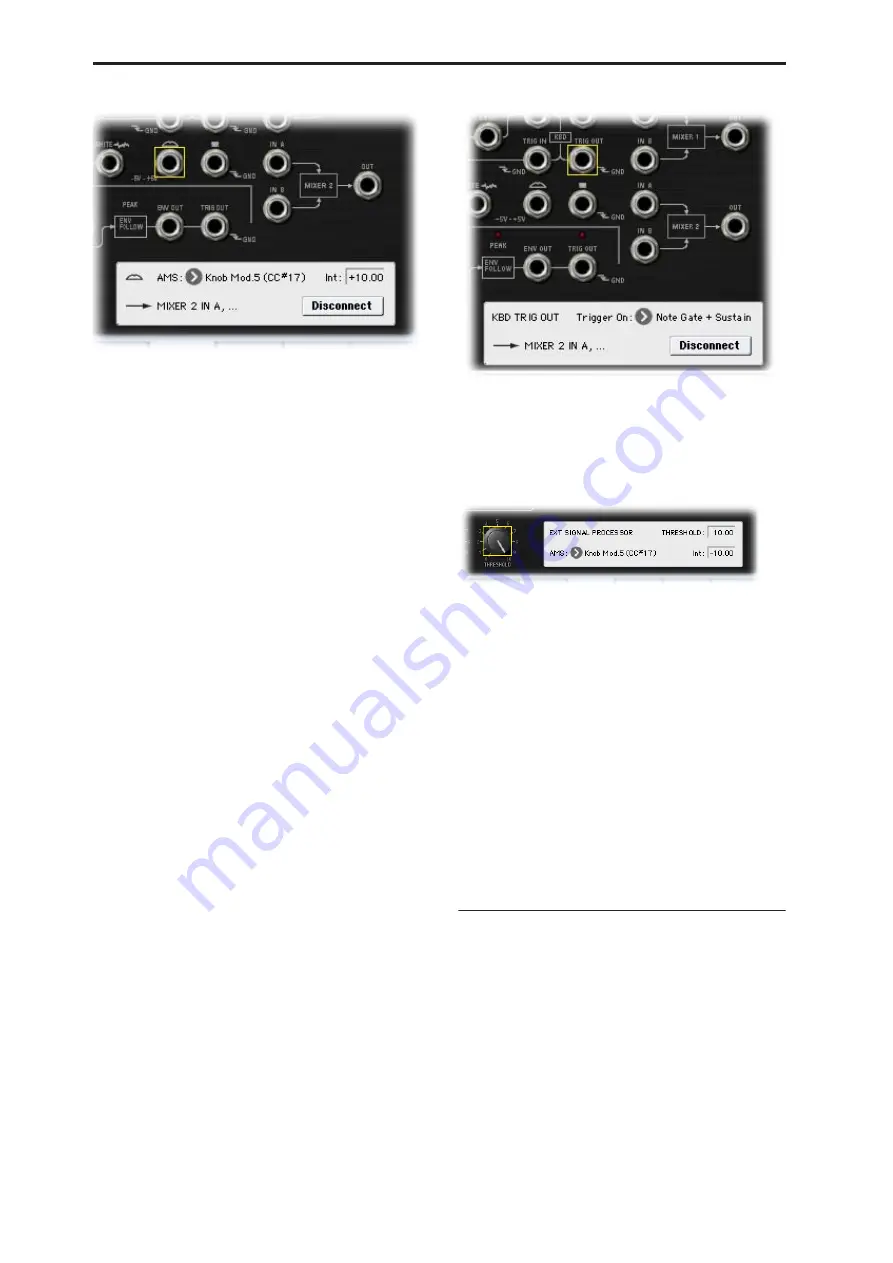
EXi: MS-20EX
302
AMS
[List of AMS Sources]
This selects the modulation source to route into the
patch panel. For a list of AMS sources, see “AMS
(Alternate Modulation Source) List” on page 967.
Important
: on the original MS-20, the Mod Wheel was
a bipolar modulation source–meaning that the center
position produced no modulation, moving down from
the center made the value lower, and moving up from
the center made the value higher.
The MS-20EX has a number of bipolar modulation
sources, including the LFOs, EGs 3-6, and the Common
Step Sequencer. JS+Y (the equivalent of the Mod
Wheel), on the other hand, is unipolar.
You can use an AMS Mixer to convert JS+Y into a
bipolar signal, if you like. To do so:
1. On the AMS Mixer page, set the Mixer Type to
Offset.
2. Select JS+Y as AMS A.
3. Set AMS A Offset to -99.
4. Set AMS A Amount to +199.
These settings shift JS+Y down and then double its
range, creating a bipolar signal.
5. In the Patch Panel, set the Mod Wheel jack to use
the AMS Mixer (instead of JS+Y).
The Mod Wheel jack will now carry the bipolar JS+Y
signal.
Int (Intensity)
[range depends on parameter]
This controls the depth and polarity of the AMS signal.
KBD TRIG OUT jack
In addition to the functionality described under “Input
and Output Jacks,” above, this jack lets you select the
trigger type, as below.
Trigger On
[Note Gate + Sustain, Note Gate]
Note Gate + Sustain
is the default, and is most
appropriate for general use.
Note Gate
is useful for keyboard trigger operation
within self-triggering patches. For more information,
see “Tip: Creating self-triggering patches” on page 295.
Knobs
If a knob is selected, this area shows its parameter
group and parameter name, its exact value, and its
AMS assignments. All six Patch Panel knobs, including
Master Volume, are modulatable.
(Parameter group)
This shows the group of the parameter (such as VCO
MIXER).
(Parameter name) [range depends on parameter]
This shows the name and exact value of the parameter.
You can edit the parameter value with any of the
standard data-entry controls.
AMS
[List of AMS Sources]
This selects a modulation source to control the selected
parameter. For a list of AMS sources, see “AMS
(Alternate Modulation Source) List” on page 967.
Int (Intensity)
[range depends on parameter]
This controls the depth and direction of the AMS
modulation.
▼
6–1: Page Menu Commands
The number before each command shows its ENTER +
number-key shortcut. For more information on these
shortcuts, see “ENTER + 0-9: shortcuts for menu
commands” on page 138.
• 0:
Write Program
. For more information, see “Write
• 1:
Exclusive Solo
. For more information, see
• 2:
Delete All Connections
. For more information,
Summary of Contents for Electronic Keyboard
Page 1: ...Parameter Guide Parameter Guide ...
Page 2: ......
Page 180: ...Program mode EXi 170 ...
Page 290: ...EXi STR 1 Plucked String 280 ...
Page 572: ...Sequencer mode 562 ...
Page 700: ...Global mode 690 ...
Page 751: ...Insert Effects IFX1 IFX12 Routing 741 Fig 2 3a Fig 2 3b ...
Page 902: ...Effect Guide 892 ...






























